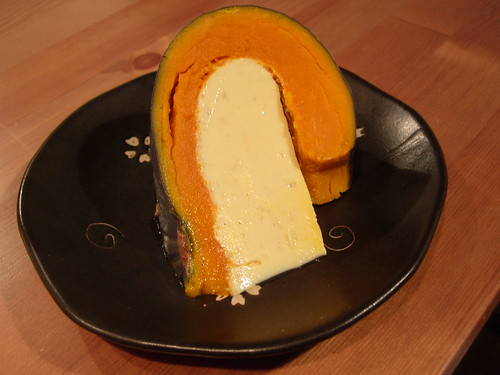I stumbled on the blog No Recipes, and saw this lovely post on a custard-stuffed steamed kabocha squash. Kabocha is in season here, and this looked like just the thing for the oven-challenged. 'Course he made his by steaming in a pot in an oven, but I figured I could just modify it for a pot. I won't give a recipe, because he gives one and I don't want to steal his thunder. Here's his picture (nicer than mine).
I also thought I should modify the flavorings. He uses things like cardamom and nutmeg, but for me it made more sense to use ginger and yuzu peel. (Incidentally, that don't look like a kabocha to me, but whatever.)
Now, I did have some minor trouble finding condensed milk, but it wasn't all that tricky -- I just stopped fooling around and went to Daimaru, the department store a few blocks from home. Expensive, but they had what I wanted.
My main problem was that steaming in a pot didn't work as smoothly as I'd expected. It took quite a while before the custard really seemed to be set -- nearly 90 minutes, in fact -- by which point the kabocha was rather saggy. Held up, though, as kabocha are pretty tough. I expect I did it too hot or too cool. But I am also thinking of a thing Diana Kennedy does with a whole Gouda cheese (which is a ball), where she has you wrap it firmly in a smooth kitchen towel before steaming, and I wonder whether that might be the way to go here.
I do think it's something of a pity that the custard absorbs into the squash as you go, because this means that the upper part of the squash is a bit dry and bland, although on the other hand the bottom half or so is amazingly good. Next time I might try mucking about to get some kind of layering effect. Certainly I'm going to do some research on steaming a whole stuffed squash!
Here's my version -- just a slice, I'm afraid:
As you see, the end-result was very pretty, and it sure tasted great. Sam pretty much passed on the pumpkin part (excessive alliteration!), but scarfed down the custard.




6 comments:
Oh this looks good and it is lovely
Marc's looked better.
Hi, I like the sound of the yuzu ginger combo. I went with the cardamom nutmeg combo to stick with the west asian (middle eastern) thanksgiving theme I was doing. You're right, it's not a kabocha squash. As I mentioned in my post the sugar pumpkin I used didn't have a great texture so I suggested people use a kabocha instead. As for the cooking time, my custard was still luke warm when I put it in the pumpkin to steam, which gets it cooking faster. Also, I'm not sure what your steaming arrangement was, but did you do it in the oven? I've done it on the stove before and found that it will cook the pumpkin unevenly. Hope that helps.
Hi Marc,
I missed the remark about using a sugar pumpkin -- serves me right for not reading carefully!
As to steaming, I can't do it in an oven, because, like most home cooks in Japan, I haven't got an oven. Just a range. So I put it in a shallow bowl, stood that on a steamer rack in a deep pot with a little water in the bottom, and steamed from there. As to the custard being lukewarm -- good point, I don't really remember what I had for temperature, but I think it was probably close to room temp. Maybe that's why!
Hmmm... Maybe next time try to mix the eggs in while the milk is still a little hot (but not so hot it will cook the eggs). Also, since you don't have an oven available, try putting down a couple layers of foil alternating with paper towels. I think what's happening that since your heat source is coming from the bottom, the bottom is heating a lot faster than the top. If you can insulate the bottom part a little better, maybe it will cook more evenly? Good luck:-)
Try steaming the custard separately for 10-15 minutes in a shallow pan before pouring it into the squash finishing the dish. Also, if you can find Pandan leaf extract, it makes a great flavoring (1 teaspoon should do).
Post a Comment